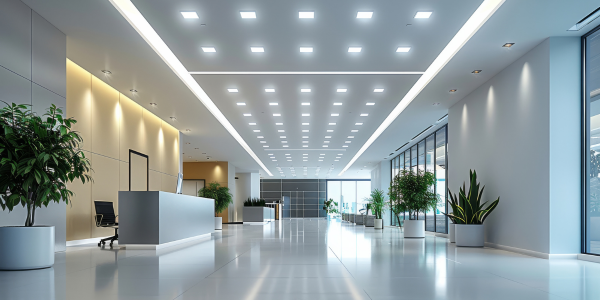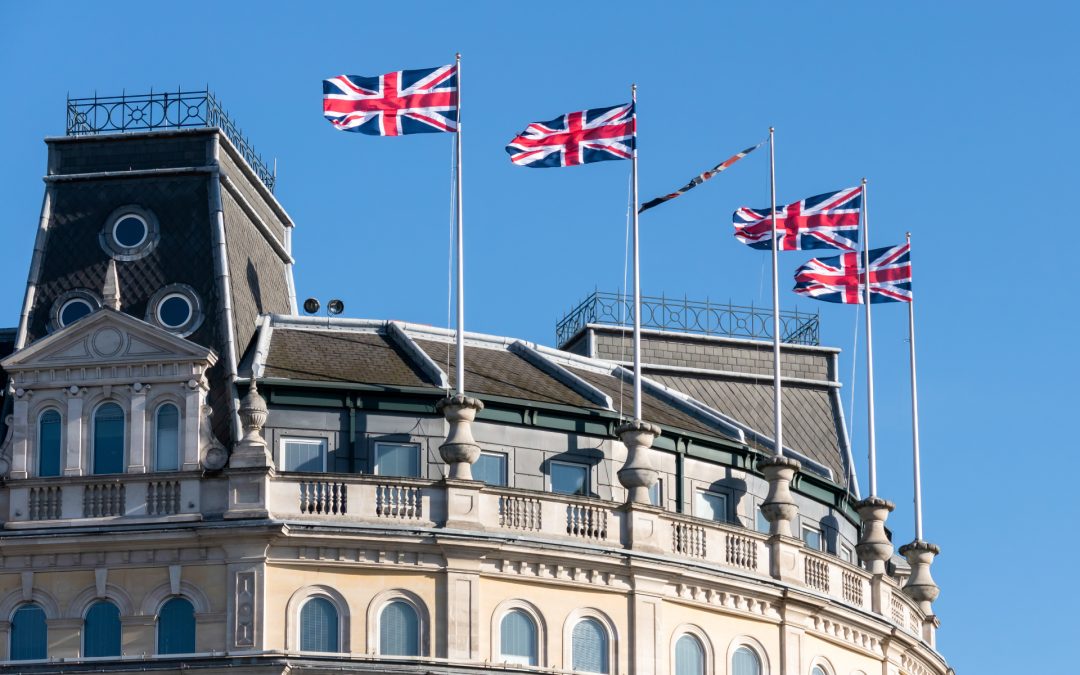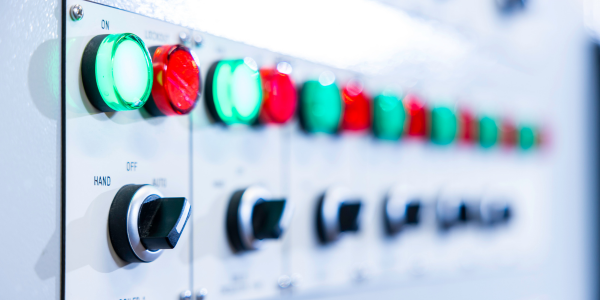Appropriate lighting is essential for employee health, safety and productivity. In the UK, strict workplace lighting regulations ensure lighting standards create optimal working conditions. This blog examines the effects of poor lighting in the workplace, the benefits of ergonomic lighting and key workplace lighting regulations. We also provide practical recommendations to resolve common lighting challenges.
Looking to improve your workplace lighting? Cube Controls provides easy, energy-efficient solutions with BMS-controlled and monitored lighting systems using the DALI communication protocol. Find out more here.
Effects of Poor Lighting in the Workplace
Insufficient lighting can negatively affect both employees’ and business performance in several ways.
Health Implications
Poor lighting conditions are strongly linked to several health issues that can negatively impact employees:
- Eye Strain: Working in dimly lit environments forces the eyes to work harder to focus, which can lead to discomfort and long-term strain.
- Headaches: Inadequate lighting can trigger headaches or migraines due to the extra effort required to process visual information in low-light conditions.
- Fatigue: Employees often feel more tired and less energetic when exposed to poor lighting.
- Decreased Concentration: Eye strain and fatigue can make it harder for employees to concentrate, which in turn can lead to increased errors.
- Increased Stress and Anxiety: Prolonged exposure to insufficient lighting has been associated with higher levels of stress and anxiety. Both can have a significant impact on both mental and physical well-being.
- Higher Sick Leave Rates: Research shows that employees working without access to natural daylight take 6.5% more sick leave, highlighting how poor lighting can directly affect health and attendance.
Safety Hazards
Poor lighting increases the risk of workplace accidents due to reduced visibility. Key risks include:
- Slips, trips and falls: Insufficient lighting in areas with obstacles or uneven surfaces (e.g., poorly lit stairwells or hallways) can cause workers to misjudge steps, leading to injuries
- Obscured hazards: Dim lighting in workspaces may hide spills, cables or other hazards, making them harder to detect and avoid.
- High-risk environments: In areas with heavy machinery or high foot traffic, poor lighting can prevent employees from spotting obstacles or reacting in time to prevent accidents.
- Reduced safety awareness: When lighting is inadequate, workers may struggle to assess their surroundings, increasing the likelihood of mistakes or injuries.
The Health and Safety Executive (HSE) stresses that proper lighting is essential for identifying risks and ensuring safety in the workplace. By improving visibility, effective lighting helps workers avoid accidents and maintain a safer environment.
Productivity Impact
The effect of lighting on workplace productivity is significant, with inadequate lighting having a direct and measurable impact on employee performance:
- Cost to UK Businesses: A study by building materials manufacturer Eurocell revealed that the lack of sufficient natural light costs UK businesses around £61.2 billion annually due to decreased productivity.
- Reduced Efficiency: When workers struggle to focus due to inadequate lighting, their speed and accuracy decrease. This directly impacts task completion times and overall productivity in the workplace.
- Increased Error Rates: Poor lighting can cause mistakes and errors in work, as employees find it harder to read, interpret data or perform tasks that require precision. The resulting increase in errors can lead to rework and delays.
To mitigate these effects, businesses and organisations are encouraged to adopt lighting standards set by official bodies, such as the Chartered Institution of Building Services Engineers (CIBSE) and the International Commission on Illumination (CIE). These organisations recommend specific illuminance levels to enhance visibility and optimise workplace performance, ensuring that lighting is suited to different tasks and work environments.
Benefits of Adequate and Ergonomic Lighting
Effective lighting solutions offer advantages that go beyond regulatory compliance, enhancing various aspects of workplace health and productivity.
Enhanced Employee Well-being With Natural Light
Adequate lighting in the workplace significantly boosts employee well-being. Exposure to natural light improves mood, reduces stress and enhances energy levels. Natural light also helps regulate circadian rhythms, leading to better alertness and reduced fatigue. Ultimately, a well-lit workplace creates a more positive atmosphere, fostering better job satisfaction.
Improved Safety Measures
Proper lighting reduces the risk of workplace accidents by improving visibility. Well-lit environments allow workers to spot hazards like spills, obstacles and machinery, reducing the likelihood of accidents. Additionally, adequate emergency lighting is crucial during emergencies, ensuring clear evacuation paths and preventing injuries when quick action is needed.
Increased Productivity With Task Lighting
Good lighting directly enhances productivity by creating a more comfortable and efficient working environment. Proper illumination reduces eye strain and fatigue, helping employees stay focused and work accurately. Task-specific lighting tailored to job needs, such as reading or detailed work, boosts efficiency and reduces mistakes. Research shows well-lit environments lead to faster task completion times, higher efficiency and overall improved performance. A bright, positive workspace also keeps employees engaged and motivated, contributing to greater workplace productivity.
Lighting Design and Levels
Lighting design plays a crucial role in shaping a workspace that is both functional and comfortable. To achieve the right lighting balance, it is important to understand the principles of lighting design and how different lighting levels support various tasks.
Planning Effective Lighting
Planning effective lighting involves considering several factors, including:
- The Type of Task(s) Being Performed: Different tasks require different lighting levels and types of lighting. For example, detailed work like reading or assembly may need higher illuminance levels, while general office work can be performed under moderate lighting.
- The Size and Layout of the Space: The size and layout of the space will affect the amount of light that is required. Larger spaces may need more powerful lighting or multiple light sources to ensure even illumination.
- The Colour and Reflectance of Surfaces: The colour and reflectance of surfaces will affect the amount of light that is reflected and absorbed. Lighter-coloured surfaces reflect more light, enhancing brightness, while darker surfaces absorb light, requiring higher illuminance levels.
- The Type of Lighting Source: The type of lighting source will affect the colour temperature, CRI (Colour Rendering Index), and luminance of the light. Choosing the right type of light bulbs, such as LED lights, can improve energy efficiency and lighting quality.
By considering these factors, building managers and facilities managers can collaborate with building services engineers to design lighting systems that meet the needs of different workspaces and promote productivity, comfort and well-being.
Workplace Lighting Regulations in the UK
Workplace lighting regulations in the UK are in place to ensure employee safety and well-being. Below is a breakdown of the key regulations and compliance requirements:
Legal Requirements
- Workplace (Health, Safety and Welfare) Regulations 1992: All workplaces must have ‘suitable and sufficient’ lighting, with a preference for natural light where possible. This regulation aims to ensure that lighting is appropriate for the nature of the tasks carried out in the workplace.
- Health and Safety at Work etc. Act 1974: Employers are required to take all reasonable steps to safeguard the health, safety and welfare of their employees. This includes providing proper lighting to avoid unnecessary risks and hazards.
Compliance Strategies
To meet these regulations, businesses should:
- Conduct Regular Assessments: Evaluate lighting conditions periodically to ensure compliance with legal standards. Regular audits help identify any lighting deficiencies or areas where improvement is needed, ensuring continued adherence to regulations.
- Maintain Lighting Fixtures: Repair or replace faulty lighting promptly. Regular maintenance schedules should be put in place to ensure that lighting systems remain in optimal condition and are free from hazards such as flickering or malfunctioning bulbs.
- Follow HSE Guidance: Use HSE resources, such as ‘Lighting at Work’, to implement best practices. These documents provide detailed guidelines on the minimum lighting requirements for different environments, helping employers stay aligned with industry standards.
- Monitor Employee Feedback: Actively seek feedback from employees regarding lighting conditions. Their input can help identify areas where lighting may not be meeting needs, improving comfort and productivity.
- Train Employees on Lighting: Educate employees on the importance of lighting, including how it affects their health, safety and productivity. Awareness of ergonomic lighting principles can encourage employees to report issues and make adjustments when needed.
- Implement Energy-Efficient Solutions: In addition to meeting safety and regulatory requirements, consider adopting energy-efficient lighting solutions that reduce costs and minimise environmental impact, ensuring compliance with sustainability goals.
- Document Compliance: Maintain records of assessments, maintenance schedules and any improvements made. Proper documentation can protect businesses in the event of an audit or investigation, demonstrating proactive steps in meeting lighting regulations.
- Implement Energy-Efficient Solutions: Consider adopting energy-efficient lighting solutions that reduce costs and minimise environmental impact, ensuring compliance with sustainability goals. Cube Controls offers fully integrated BMS-controlled and monitored DALI lighting systems, making it easier for businesses to maintain compliance while optimising energy use.
Identifying and Mitigating Poor Lighting Hazards
Recognising common lighting issues is crucial for maintaining a safe and productive work environment. Identifying these hazards early helps mitigate risks and improve overall workplace conditions.
Common Lighting Issues
Several common lighting problems can impact safety, comfort and productivity:
- Flickering Lights: These can cause eye strain and headaches, distracting workers and leading to fatigue. Regular inspection of light fixtures can prevent this issue.
- Glare: Excessive glare can cause eye strain, particularly in areas with reflective surfaces or direct sunlight. Adjusting light positioning or using diffusers can help reduce glare.
- Shadows: Poorly placed lighting creates shadows that interfere with tasks requiring precision, leading to errors. Ensuring even light distribution can minimise this issue.
- Insufficient Illumination: Low light levels make tasks harder to perform, leading to eye strain, reduced focus, and accidents. Regular light level measurements ensure compliance with standards.
Regular inspections and proper lighting design tailored to tasks are essential to maintaining a safe and productive workplace. The HSE advises that lighting should be designed to suit the tasks employees are performing.
Solutions for Improvement
To improve workplace lighting conditions:
- Upgrade Fixtures: Replace outdated or inefficient lighting with modern, energy-efficient solutions. LED lighting can provide better illumination while reducing energy costs and maintenance.
- Maximise Natural Light: Optimise the use of natural daylight by arranging workspaces near windows or incorporating skylights. This not only reduces energy consumption but also enhances employee well-being by providing exposure to natural light.
- Use Task Lighting: Provide adjustable lighting for specific tasks. Desk lamps or flexible lighting solutions can ensure that work areas have adequate illumination, reducing eye strain and improving productivity.
- Conduct a Lighting Assessment: Building managers, owners or facilities managers can schedule regular lighting assessments. Working with a Building Management System (BMS) specialist can help ensure that lighting levels are optimised and identify areas where ergonomic lighting may be beneficial. A BMS specialist can assess current lighting control systems, recommend energy-efficient solutions and tailor the lighting environment to meet the specific needs of employees.
Proper Workplace Lighting Ensures Health, Safety and Productivity
Adhering to workplace lighting regulations in the UK and implementing effective lighting solutions enables businesses to create a safer and more efficient work environment. From improving employee well-being to reducing accidents and boosting productivity, investing in adequate lighting in the workplace provides long-term benefits for both workers and organisations.
By addressing the effects of poor lighting in the workplace and using ergonomic lighting, businesses can improve comfort and performance. Regular assessments and the use of ergonomic lighting strategies are essential steps in mitigating common lighting issues, fostering a positive atmosphere and reaping the advantages of good lighting in the workplace. Ultimately, these improvements contribute to both physical health and productivity, ensuring a happier, more efficient workforce.
To help achieve these benefits seamlessly and energy-efficiently, Cube Controls offers fully integrated lighting solutions where the BMS controls and monitors lighting using the smart DALI communication protocol, simplifying management and ensuring compliance.
Partnering with Cube Controls means creating a healthier, safer and more productive workplace through advanced lighting control technology.
Cube Controls is an established and experienced supplier of Building Management Systems, specialising in the design and set up of bespoke environmental and energy control programmes for commercial buildings and property.
To find out how Cube Controls can support you at all stages of design and consultancy, installation and modification and maintenance of your building management systems c




